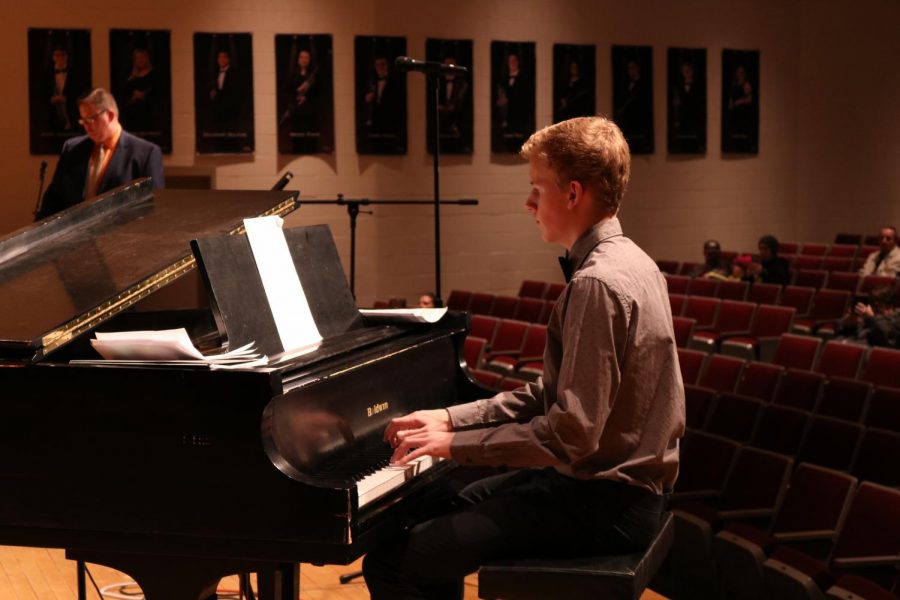The Most Influential People Behind Jazz
...Aside from the AHS Jazz Band.
November 22, 2019
Senior Evan Brummer plays piano in the AHS Jazz Band. This year, the Jazz Band’s compositions include a rendition of “Africa” by Toto and “Low Rider” by War.
With the play being set in what is probably the jazziest era–also known as the 20s–and jazz band starting up recently, I have been listening to a lot of jazz music. Here are the stories of some of my favorites I have been listening to in no particular order.
John Coltrane
According to a website dedicated to John Coltrane, jazz journalist Nat Hentoff once said, “By the time “A Love Supreme” hit, Trane struck such a spiritual cord in so many listeners that people started to think of him as being beyond human. I think that’s unfair. He was just a human being like you and me–but he was willing to practice more, to do all the things that someone has to do to excel. The real value in what John Coltrane did was that what he accomplished, he did it as human.” Coltrane grew up listening to early jazz, which really influenced his musical style. Coltrane played the tenor saxophone. Some of his most famous songs include “A Love Supreme,” “Equinox,” and “My Favorite Things.”
Duke Ellington
Duke Ellington wrote his first composition at the age of 15, and it was called “Soda Fountain Rag.” It was inspired by his job as a “soda jerk.” Ellington began to play professionally at the age of 17. Ellington played the piano, and also penned some of the biggest ragtime hits. Some of his most famous songs include, “It Don’t Mean A Thing If It Ain’t Got That Swing,” “Take the A Train,” and “Sophisticated Lady.” Ellington died of lung cancer and pneumonia on May 24, 1974. His last words were, “Music is how I live, why I live, and how I will be remembered.”
Charlie Parker
Charlie Parker, along with fellow musician Dizzy Gilespie, was one of the inventors of the musical style of bebop. From 1935-39 (ages 15-19), Parker played in different Missouri nightclubs and with local jazz bands. According to a biography about him, Parker’s mother had given him a saxophone as a gift to try and make up for his father leaving them when he was young. In 1945, Parker went on a six-week nightclub tour of Hollywood with Gilespie, and on that six week tour, they somehow managed to create bebop. Parker and Gilespie recorded the album “Bird and Diz” in 1950.
Louis Armstrong
When Louis Armstrong was born in New Orleans, La., his father left. Armstrong was forced to quit school, and to go to work just after the fifth grade. Armstrong was employed by a local Jewish family to do simple jobs like collecting junk, and delivering coal. He learned to play the trumpet at a boys’ home. Armstrong would up at the boys home at age 11, when he shot his stepfather’s gun into the air. In result, he was arrested on the spot. Armstrong recorded many albums in his long career. Some of his most famous songs include “What A Wonderful World,” “La Vie En Rose,” and “StarDust.”
Cannonball Adderley
Cannonball Adderley was born with the name Julian Edwin Adderley. He formed his first quintet with his brother, Nat, but was not very successful. Jazz music was in the family as his father was a jazz cornetist. Adderley himself was inspired by both the bebops of Charlie Parker, and the more traditional style of Benny Carter. In 1957, Cannonball worked with Miles Davis and John Coltrane. Both are considered very prominent jazz musicians. In 1959, the Adderley siblings tried again to form a quintet, and were successful the second time around. Some of his songs include, “Mercy, Mercy, Mercy,” “This Here,” and “Work Song.”
Ella Fitzgerald
Ella Fitzgerald is probably one of the most well-known female jazz singers of the 20th century. Over the course of her career, she recorded over 200 albums, and many of the most influential jazz musicians including Louis Armstrong had the pleasure of working with this iconic musician. In 1986, she was diagnosed with diabetes, and later needed to get both of her legs amputated from the knees down. Because of the surgery, Fitzgerald was unable to perform as often, but she still did whenever she could. She passed away on June 15, 1996. Some of her songs include, “Dream A Little Dream,” (with Louis Armstrong), “Cheek to Cheek,” (with Louis Armstrong), and “These Foolish Things (Remind Me of You).”
